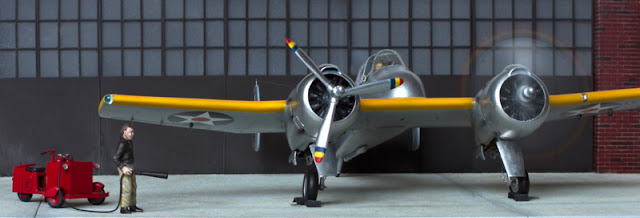1. Introduction
1.1. Aircraft
Grumman XF5F-1 Skyrocket
Prototype carrier-based fighter (information in Wikipedia)
U.S. Navy. BuNo 1442.
Grumman factory, Bethpage, USA, 1940.
1.1. Aircraft
Grumman XF5F-1 Skyrocket
Prototype carrier-based fighter (information in Wikipedia)
U.S. Navy. BuNo 1442.
Grumman factory, Bethpage, USA, 1940.

1.2. Story
The XF5F-1 is being prepared for yet another test flight at the Grumman factory airfield. Its pilot is already in the cockpit. A ground crewman is standing by, close to the factory's improvised fire engine, a Cushman scooter.
The XF5F-1 is being prepared for yet another test flight at the Grumman factory airfield. Its pilot is already in the cockpit. A ground crewman is standing by, close to the factory's improvised fire engine, a Cushman scooter.
XF5F-1 Skyrocket from MPM (kit # 72022), 1:72 scale.
3. Construction
3.1. Building
3.1. Building
Although the accuracy of the kit is more or less acceptable out of the box, it really lacks details and requires quite a lot of wok to get a realistically looking model. I have added the following fully scratch-built items:
1) Landing gear well interior. This was "guessworked", as no historical photographs are available.
2) Landing gear legs and struts.
3) Landing gear door interior and hinges.
4) Propeller hubs.
5) Instrument panel and cockpit interior.
6) Fuselage downward-vision window.
7) Catapult bridle hooks.
8) Clear external lights, including:
a) Clear white dorsal and rear navigation lights.
b) Red and green navigation lights – two wingtip ones plus two on the upper wing surface.
c) Landing light and approach light on the starboard wing.
2) Landing gear legs and struts.
3) Landing gear door interior and hinges.
4) Propeller hubs.
5) Instrument panel and cockpit interior.
6) Fuselage downward-vision window.
7) Catapult bridle hooks.
8) Clear external lights, including:
a) Clear white dorsal and rear navigation lights.
b) Red and green navigation lights – two wingtip ones plus two on the upper wing surface.
c) Landing light and approach light on the starboard wing.
Then, bringing the model to a "definitive" short-nose XF5F-1 version required the following modifications to be done:
9) Fuselage-to-wing fillets added.
10) Rudder hinge lines revised (from straight ones to stepped ones).
11) One long side-mounted exhaust stack per engine replaced with 9 smaller exhaust stacks.
12) Small air intakes removed from the engine cowlings' lower lips.
9) Fuselage-to-wing fillets added.
10) Rudder hinge lines revised (from straight ones to stepped ones).
11) One long side-mounted exhaust stack per engine replaced with 9 smaller exhaust stacks.
12) Small air intakes removed from the engine cowlings' lower lips.
Finally, a bit of aftermarket had to be added.
13) This came in the form of two resin R-1820 engines from a set by QuickBoost (# 72059). I know that, technically, these engines are of the "wrong" version, but anything would be better than the sad pieces of plastic that came with the kit.
13) This came in the form of two resin R-1820 engines from a set by QuickBoost (# 72059). I know that, technically, these engines are of the "wrong" version, but anything would be better than the sad pieces of plastic that came with the kit.
3.2. Painting & Markings
The top surface of the wing is Chrome Yellow (note that the yellow overlaps the leading edge). A careful study of historical photographs will tell you that this machine had its fuselage painted in Aluminium color and not in Naval Aircraft Grey, as prescribed by the Navy's official directives. The rest of the airframe is also Aluminium. The national insignia decals came from a generic sheet by Techmod, and the identification number decals are from various leftovers.
The top surface of the wing is Chrome Yellow (note that the yellow overlaps the leading edge). A careful study of historical photographs will tell you that this machine had its fuselage painted in Aluminium color and not in Naval Aircraft Grey, as prescribed by the Navy's official directives. The rest of the airframe is also Aluminium. The national insignia decals came from a generic sheet by Techmod, and the identification number decals are from various leftovers.
3.3. Presentation
There is a couple of well-known historic photographs that show the XF5F-1 on the Grumman factory field, sitting on the concrete in front of a hangar, being readied for a flight. It is this setup that I decided to replicate. So my diorama base and the fragment of that hangar front face were scratch-built from sheet plastic in accordance with those photographs.
There is a couple of well-known historic photographs that show the XF5F-1 on the Grumman factory field, sitting on the concrete in front of a hangar, being readied for a flight. It is this setup that I decided to replicate. So my diorama base and the fragment of that hangar front face were scratch-built from sheet plastic in accordance with those photographs.
The seated pilot figure is from a set # 721120 made by PJ Productions. Despite the name of that set ("US Pilots Seated WW2"), the figures' headgear is totally wrong for the period. I had to find a new head, and that came from an excellent set of standing USN pilot figures produced by CMK of Czech Republic (# 72115). The ground crewman figure is from another good CMK set (# 72110).
Cushman delivery scooters customized as "very light" fire engines have been in use on the Grumman's factory field: see this historical photograph. I scratch-built this tiny vehicle and added it to my little diorama.
4. Reference Data
[1] General information on the XF5F in Wikipedia: link
[2] Grumman XF5F-1 & XP-50 Skyrocket | Naval Fighters Series # 31 | Ginter Books, 1995.
[3] Grumman F7F Tigercat | Monografie Lotnicze Series # 1 | AJ-Press, 1991.
[2] Grumman XF5F-1 & XP-50 Skyrocket | Naval Fighters Series # 31 | Ginter Books, 1995.
[3] Grumman F7F Tigercat | Monografie Lotnicze Series # 1 | AJ-Press, 1991.









